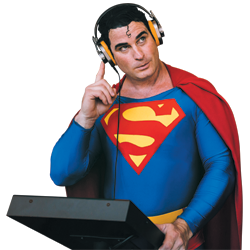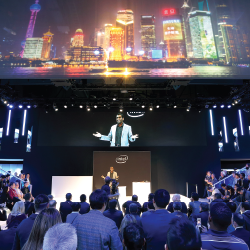You don't need a theater degree to pull off a successful live presentation the first time out, but you do need to avoid these five common mistakes that will turn even the most amusing farce into a flop. By Candy Adams

lanning and executing an in-booth presentation for the first time can be a daunting undertaking. From monotone presenters and uncomfortable seating to inadequate sound systems, there are plenty of potential snafus. In a perfect world, none of that would matter as long as the content was strong. Trouble is, all of those factors impede attendees' ability – and willingness – to pay attention for any amount of time. While I can write about the importance of key messages, timing, rehearsals, stage presence, etc. until the cows come home, a presentation is doomed before the curtain rises if your exhibit lacks the right physical pieces to
literally set the stage.
Here, then, are the five most common mistakes exhibitors make when it comes to creating in-booth theaters.
 Too Little or Too Much Seating
Too Little or Too Much Seating
We've all crowded in the aisles to catch a presentation when there weren't any seats left, and we've also likely been in the company of only one or two other people in the audience when there were far too many seats. Both scenarios are awkward, and while not entirely avoidable – you can't always predict the number of people that will show up – there are things you can do to prevent them from happening.
To figure out the right amount of space to allocate for a theater, first determine how many people you want in the audience. This number will be dictated by several factors, including exhibit size as well as presentation schedule, length, and format. For example, if you anticipate swarms of attendees crowding your presentations and want to maximize the available theater area, keep the presentation short – not more than 5 minutes – and eliminate seating to provide standing-room only. This no-seating tactic not only doubles the number of visitors able to pack into the space, but also negates the need for furnishings while increasing the reach of your message.
On the other hand, if you have a 20-by-20-foot exhibit and plan on having 10-minute presentations every half hour, during which an interactive Q & A will take place, then keep the audience on the smaller side. You could do two rows of three stools or chairs, giving the presenter equal access to everyone and vice versa. The setup fosters a more intimate exchange that encourages interaction.
 Violating Confines of Booth
Violating Confines of Booth
Regardless of the seating selected, know that your exhibit will likely be subject to a clause in the booth-space contract called "confines of booth." In short, it states whatever exhibitors do to market themselves must be done within the rented booth space and not in common areas including the aisles. If your speaker is a hit with attendees, and your theater attracts a standing-room-only crowd that spills out into the aisle, you may very well receive a visit from show management.
If you anticipate a crowd, be proactive. Rent stanchions and set up a queueing area for people to wait in line. You can also post presentation schedules on placards visible from the aisles, and encourage attendees to come back early for the next show so they can grab a seat.
While show management understands that exhibitors can't control aisle traffic, it can mandate that you hire security to keep the crowd moving if people continually block aisle traffic to neighboring exhibitors.
 Inadequate Stage Height
Inadequate Stage Height
Whether you're at the movies, on Broadway, or in a booth, there's nothing worse than not being able to see what's happening on a stage. So hand in hand with your choice of seating is determining whether the presenter needs to be on an elevated platform. I wish there was a hard and fast formula I could share, but there are so many variables to consider, including theater size, seating type and height, distance from the back and front row to the presenter, riser/stage height (from 16 to 40 inches), and backdrop visibility.
For example, if you have a 10-by-10-foot area sectioned off for your presentation space and use six or so low ottomans for seating, you likely won't need a riser or stage. However, if your theater space is 20-by-20 feet, contains several rows of banquet chairs, and has a back row that's 15 feet from where the presenter stands, then a riser of at least 16 inches will vastly improve visibility. You want to make sure people seated in the back row can see over the people seated in the front row so they can see the presentation. So as your expected audience and space grows, so should the height of the stage.
 Insufficient Audio
Insufficient Audio
I don't have to tell you that exhibit acoustics are a crapshoot, and it's for that reason that you need to plan for the correct audio equipment to ensure your presentation actually gets heard.
The sky's the limit when it comes to sound equipment, and there isn't an industry standard to figure out what components are required for an exhibit theater. It depends on the size of the space, the number of people expected to attend, the ability of the presenter to project, etc. However, there are typical setups. For example, if the theater is 30 feet deep, there should be at least two 100-watt speakers (one on either side of the stage) with an amp and mixer to balance the sound. This is paired with a handheld or headset mic for the presenter.
When I need sound-enhancing equipment, I consult my audiovisual contractor (or the show-appointed contractor, if necessary). I send it a copy of my booth layout that shows details about the theater, including the location of the presenter and/or lectern, the number of chairs in the space, the height of the stage, etc. After it specs out what I'll need, I consider placement of the speakers, amps, and soundboard, making sure they are accessible for staff but out of the way of attendee traffic.
Before finalizing your plans, check the limitations published in the exhibitor services manual's rules and regulations regarding sound levels. There is an industry standard set by the International Association of Exhibitions and Events Guidelines for Display Rules and Regulations that states, "In general, exhibitors may use sound equipment in their booths so long as the noise level does not disrupt the activities of neighboring exhibitors. Speakers and other sound devices should be positioned so as to direct sound into the booth rather than into the aisle. Rule of thumb: Sound and noise should not exceed 85 decibels when measured from the aisle immediately in front of a booth."
 Poor Lighting
Poor Lighting
Unless you have a fully enclosed theater with a ceiling structure that blocks overhead light, you're at the mercy of the convention center's lighting. Exhibitors can typically request that show management turn off lights above an exhibit during a show, but be prepared to pay to have bulbs removed if the show electricians can't simply turn them off with the flip of a switch. The plus side is that you will have more control over the lighting in your exhibit and presentation area. The downside is that neighboring exhibitors can file a complaint and request that the lights are turned back on, so you won't know if you'll be able to count on that option until the theater is completely installed at the show.
Curtain Call
As exhibit marketers, it's tempting to focus all your time and energy on a presentation's content, key messaging, and promotion. But it's equally as important to create the right space for your message to be heard. By sidestepping the aforementioned mistakes, you'll be queued up for an encore-worthy performance.




 lanning and executing an in-booth presentation for the first time can be a daunting undertaking. From monotone presenters and uncomfortable seating to inadequate sound systems, there are plenty of potential snafus. In a perfect world, none of that would matter as long as the content was strong. Trouble is, all of those factors impede attendees' ability – and willingness – to pay attention for any amount of time. While I can write about the importance of key messages, timing, rehearsals, stage presence, etc. until the cows come home, a presentation is doomed before the curtain rises if your exhibit lacks the right physical pieces to
literally set the stage.
lanning and executing an in-booth presentation for the first time can be a daunting undertaking. From monotone presenters and uncomfortable seating to inadequate sound systems, there are plenty of potential snafus. In a perfect world, none of that would matter as long as the content was strong. Trouble is, all of those factors impede attendees' ability – and willingness – to pay attention for any amount of time. While I can write about the importance of key messages, timing, rehearsals, stage presence, etc. until the cows come home, a presentation is doomed before the curtain rises if your exhibit lacks the right physical pieces to
literally set the stage. 



